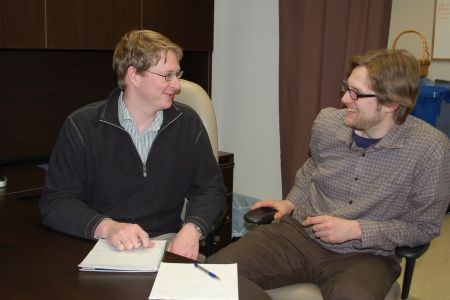A small Sudbury firm is helping mining companies peer into the future to avoid costly mistakes.
Labrecque Technologies creates computer models of mine operations before they are developed in order to analyze and solve any potential problems.
“Mining companies can spend billions of dollars on development projects.
We can build that mine in the computer before any actual work is done to help them make key decisions,” said Pierre Labrecque, president of Labrecque Technologies.
Those decisions can include the design of the mine and related processes, sizing the equipment fleet, looking for bottlenecks, sizing the bins and ore passes, doing tradeoffs and estimating production.
Labrecque has been doing simulation work for more than eight years.
In 2008, he started his own company after working at a major engineering consulting company for six years.
A year later, he hired Adam Kalviainen; now, together, the two mechanical engineers are now offering a niche service to the mining industry.
Their clients range from juniors to large multi-national mining companies throughout the world.
Most of the projects have been block cave mines that range in capacity from 40,000 to 160,000 tonnes per day.
“There is a growing demand for this type of work within the mining industry,” said Labrecque. “The airline and manufacturing industries have been taking advantage of this type of analysis for a longer time.
Now, simulation has become part of the feasibility studies that larger mining companies are doing.”
While most consulting firms have some staff trained to perform simulations, not many are focusing on mining.
Labrecque and Kalviainen enjoy the work and the coding that is required.
The software they use includes Arena by Rockwell Automation, and Sim- Mine, which originates in Sweden.
Labrecque is also the sole Canadian distributor of SimMine.
“We both get to build the mine on the computer,” said Kalviainen. “We have a layout, which is the visual representation, and then the code is what makes things happen on the layout, such as making the equipment do all that it is supposed to.
For instance, we can make the trucks go to a certain chute, and then drive to a crusher.”
While the simulation may be analogous to a video game, the work they do is integral to the companies’ future plans.
“Our clients are relying on the analysis of our modeling to make multi-million-dollar decisions.
We are helping them with tradeoffs in terms of design, and figuring out things like where the ore passes should go and what size trucks they should use.”
The simulated models can take into account countless variables such as equipment interference, the queuing of trucks, random breakdowns and random process times.
“The compounding effect of all these different dynamics is something that is just impossible to capture in a spreadsheet,” said Kalviainen.
“The modeling we do is the closest thing you can get to operating your mine in real life before you actually build it.”
Several days can be spent with clients ensuring they understand what is being built. The model can involve more than 1,000 inputs, which can be changed and tweaked.
If a problem is encountered, options are discussed with the client to find a solution.
Their simulation work is also being used for research and development of new prototype mining equipment by helping to predict performance.
“Using simulation models, we are introducing the equipment into an existing mine and seeing how it is going to work and interact,” said Labrecque.




